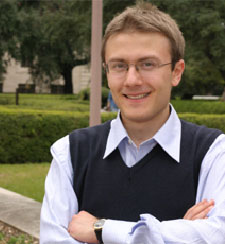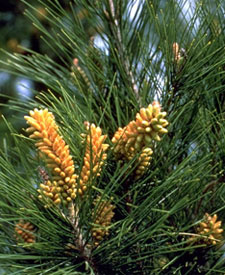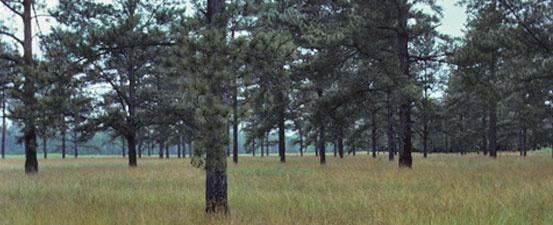Hope for Lost Pines
IT HAD BEEN 100 YEARS since Texas had suffered anything like the drought and heat it did this year. And just when the first signs of fall were imminent, drought-induced wildfires began to blaze across the state.
Bastrop County in East Central Texas suffered the worst — 34,000 acres of it burned and more than 1,600 family homes were destroyed. The Wildflower Center is now part of an effort to help restore the burned residential landscapes with native plants and trees. One graduate student with a big goal put the Center at the heart of an operation to help homeowners repopulate the burned areas with more than 100,000 native trees, including loblolly pines (Pinus taeda). Before the drought and wildfires, these made up more than 6,000 acres of lush forest in the Bastrop area, the site of an isolated loblolly pine woodland known as Lost Pines.
 Vlad Codrea (left) is creating a tree nursery at the Wildflower Center thanks to a grant from the university’s Green Fee Committee.Vlad Codrea studies molecular biology not botany at The University of Texas at Austin but was moved by the opportunity to assist people who had lost their landscapes to the wildfires. Applying for a grant from the university’s new Green Fee program seemed like a great way to help carry out his plan for creating a tree nursery that would benefit the burned areas. Codrea’s project is one of 16 campus-based environmental service initiatives awarded funding this year by the university’s Green Fee Committee. A grant of $54,000 over three years will help Codrea oversee a growing operation at the Wildflower Center capable of producing as many as 100,000 seedlings per year — half of them the beloved loblolly pine. Bur oak (Quercus macrocarpa), bald cypress (Taxodium distichum), cedar elm (Ulmus crassifolia) and American sycamore (Platanus occidentalis) will also be grown.
Vlad Codrea (left) is creating a tree nursery at the Wildflower Center thanks to a grant from the university’s Green Fee Committee.Vlad Codrea studies molecular biology not botany at The University of Texas at Austin but was moved by the opportunity to assist people who had lost their landscapes to the wildfires. Applying for a grant from the university’s new Green Fee program seemed like a great way to help carry out his plan for creating a tree nursery that would benefit the burned areas. Codrea’s project is one of 16 campus-based environmental service initiatives awarded funding this year by the university’s Green Fee Committee. A grant of $54,000 over three years will help Codrea oversee a growing operation at the Wildflower Center capable of producing as many as 100,000 seedlings per year — half of them the beloved loblolly pine. Bur oak (Quercus macrocarpa), bald cypress (Taxodium distichum), cedar elm (Ulmus crassifolia) and American sycamore (Platanus occidentalis) will also be grown.
“I’ve always loved the stately silhouette of conifers and the sight of large expanses of land covered by verdant forests. I think Bastrop’s Lost Pines are a real recreational treasure for Central Texans, who would otherwise have to drive long ways before encountering similar scenery,” says Codrea. “In addition, the loblolly pines in this area are adapted to survive with less rainfall than any other population of this staple species of the timber industry. The Lost Pines thus offer a unique genetic resource poised to help mitigate the negative economic effects that more frequent, climate change-related droughts have on timber plantations throughout the southeastern United States.”
 Loblolly pine is the principal commercial southern pine, a large, resinous, and fragrant tree with rounded crown of spreading branches.
Loblolly pine is the principal commercial southern pine, a large, resinous, and fragrant tree with rounded crown of spreading branches.The Wildflower Center was able to use proceeds of this October’s Balcones Burner Bash — an urban art festival sponsored by Balcones Recycling and others for the benefit of the Center — to improve its tree-growing operation area and help get Codrea’s project underway.
The Texas Forest Service donated hundreds of thousands of loblolly pine seeds collected from the burned area before the wildfires, and construction of a greenhouse has begun. With the help of Wildflower Center staff and student volunteers from the university’s largest environmental student organization — the Campus Environmental Center, Codrea will begin the work of growing seedlings in the new year. After the trees are strong enough to survive transplant, Roxanne Hernandez of Bastrop County’s Lost Pines Recovery Team steps in. Her job in the aftermath of the wildfires is to coordinate the restoration effort for the environment and natural resources. Working with governmental and nongovernmental entities — like the Wildflower Center — is part of what’s involved in getting natives back in the landscape. Her team will get trees like those grown at the Center in the hands of homeowners for free or reduced cost.
“It would be very easy for homeowners to plant non-natives now that their landscapes are burned,” says Hernandez. “We want to see a restoration of the ecosystem not a modification. We don’t want to go from what was primarily native habitat to a non-native habitat because of lack of information or resources among homeowners.”
So far, Hernandez has been pleased with the amount of interest in putting natives back in the Bastrop landscape. “So far, there have been a lot of requests for native seed for grasses and forbs.”
In a year’s time Codrea will begin to see the first of the trees grown at the Center make their way to Bastrop. Austin-based Tree Folks — which coordinates tree-planting events — will make sure those trees get in the ground by enlisting communities and schools to do so.
 Loblolly Pine is native in 15 southeastern states. Among the fastest-growing southern pines, it is extensively cultivated in forest plantations for pulpwood and lumber.
Loblolly Pine is native in 15 southeastern states. Among the fastest-growing southern pines, it is extensively cultivated in forest plantations for pulpwood and lumber.As the director of Sustainability for the University of Texas at Austin, Jim Walker acts as a project manager for the Green Fee Committee Initiative.
“Vlad has a lot of enthusiasm and a strong vision for this project. Together with the horticultural expertise and long term stability of the Wildflower Center, I think UT students will be providing trees throughout Central Texas for a long time,” says Walker.
“The partnership that has developed between Vlad and the Wildflower Center is really a model for how we hope Green Fee projects can be leveraged with strong partners to create meaningful student experiences and meaningful environmental investments on campus and in our region.”
Wildflower Center Senior Director Damon Waitt says the project is a great example of the type of collaborative work the Center loves to do — and for such a great cause.
“We were very happy to find a way where we could contribute to the restoration of this unique ecosystem and help heal the fire damaged community.”

